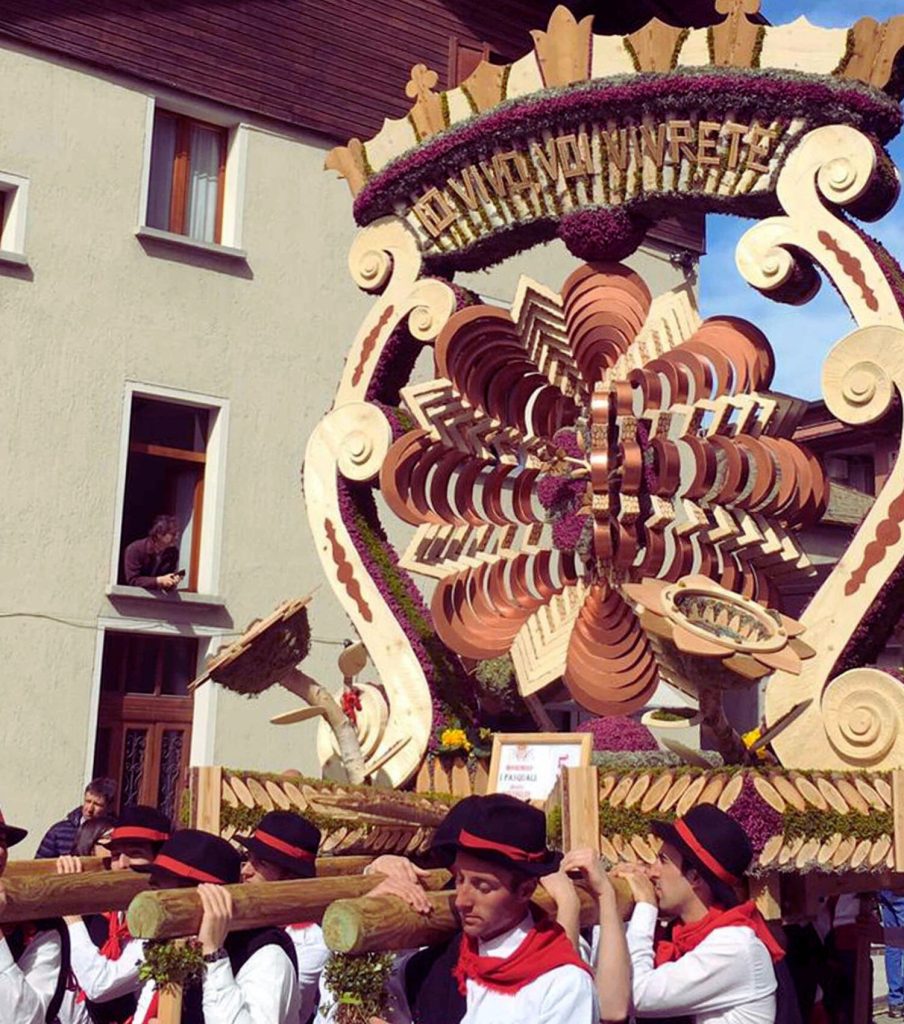For many Italian travelers and not only, Easter is the ideal time to discover the wonders of Italy. The mild climate invites you to travel and, from north to south, there are many opportunities for a meeting with local folklore, during one of the many regional celebrations.
One of the most anticipated events of the year in Valtellina are the Pasquali di Bormio, an ancient festival, which dates back to the Middle Ages, for which the whole community prepares with care in previous months.
What are the Easter cards?
Already in the nineteenth century the custom of blessing lambs had spread in Bormio and the districts of the country were challenged to those who decorated with more pomp the sedan on which the animals were transported, lying on soft moss. Over the years the sedans have evolved into real works of art, elaborate and decorated with detail.
Today, therefore, the Pasquali of Bormio are the celebration rooted in the pastoral and rural culture of this area. The inhabitants of the different districts (Buglio, Combo, Dossiglio, Dossorovina and Maggiore) are called to compete in an artistic competition, a bit like in the cities that are preparing for Carnival through the construction of floats. Thanks to the craftsmanship of the bormini every year take shape real masterpieces carved mainly in wood, adorned with flowers and plants.
An exciting aspect of the festival is undoubtedly the pride with which those who live here organize every detail, from the creation of costumes to the care of floral gifts.
Pasquale is made in great secrecy and always expresses a religious message, as well as an artistic work. The set of the two things, consistent with the sense of Easter and well harmonized, will be the subject of judgment by the jury responsible for deciding the winning district.
In the middle of the party
The “Pasqualists” are the ones designated to carry the Pasquali on their shoulders: they are mainly the young people of the village, accompanied by women, the elderly and children, all dressed in the typical costumes of the festival.
On Easter morning bormini and tourists gather along the streets and people flock to every corner to admire the parade. The groups prepare themselves: the children carry the Pasquale on their shoulders, while the other participants offer gifts in the form of flowers or crafts, created following the teachings of the elderly.
Pasquali, of different sizes and weights, are carried with great pride. Adults parade large sedans, real carpentry and engineering, while children carry smaller ones. The parade starts from via Roma and reaches the square of Kuerc, with the gangs of the neighborhoods and women, the elderly and children who precede the Easter.
The festival begins on arrival in the square, at the first stroke of Bajona, the ancient bell symbol of Bormio whose call can be heard up to the surrounding valleys further away.
A journey through mountain flavours
Bormio is immersed in a unique landscape: mountains, rivers and woods create an environment rich in biodiversity, which directly affects the local cuisine, made of quality raw materials, skilfully mixed in recipes handed down from generation to generation.
Participating in the festival is an opportunity to taste at least part of the culinary heritage of the area. In the trattorias, in the good restaurants and in the crotti (natural cellars with a source of fresh air always open) you can taste earthy dishes steeped in history as well as taste, meats and cheeses unavailable elsewhere.

Foto: ilgiorno
Among the specialties we find…
Pizzoccheri della Valtellina: a rustic pasta made with buckwheat flour that has earned the IGP designation. It is served with savoy cabbage, potatoes, Valtellina Casera cheese and melted butter.
Bresaola: delicious salami typical of Valtellina, obtained from aged and flavored beef. The Violino di Capra cut is very rare, while the Slinzega offers a stronger taste.
Polenta Taragna: a creamy polenta prepared with buckwheat flour and corn flour, often accompanied by local cheeses and game.
Sciatt: small balls of fried dough filled with melted cheese.
Taroz: characteristic dish consisting of potatoes, green beans, onion, butter and cheese.
Chisciol: large thin pancake made from buckwheat flour and cheese Casera filante, typical of the Tirano area.
Bisciola: mountain variant of the Panettone, is made exclusively with local ingredients and enriched with dried fruit, raisins, dried figs and honey.
Curnat: they are a tasty dessert of the Valtellina tradition, prepared with flour, sugar, butter and eggs, often accompanied by raspberry jam or blueberries.
Cupeta: is an ancient cake made of wafers, honey and nuts, originally cooked for the festivities of some saints.
The particular geographical conformation of Valtellina, with its steep terraces exposed to the sun, also gives the wines of the region a distinctive quality and a unique character that makes them highly appreciated, both nationally and internationally. The most successful and beloved wines are those obtained from Nebbiolo grapes, locally known as Chiavennasca.
Autore: Eleonora Di Mauro
Copertina: ilgiorno



